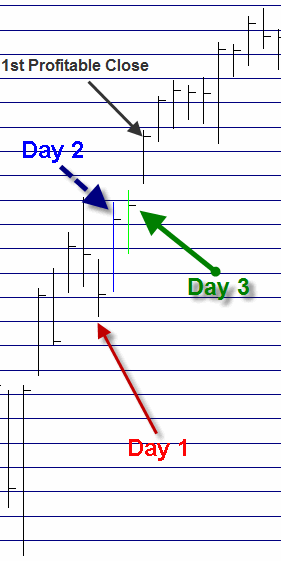See Jay’s latest post: One More Plunge for Crude Oil?
It’s been (alas, correctly) brought to my attention that my description of the “Simple Pattern” I wrote about was, um, not so simple. To wit, the author writes:
“Not every Day 1 signal generates an entry signal. If the 2nd trading day after the “close below previous low” (Day 3) does not trade above the high of the day after the “close below previous low” day (Day 2), then no further entry signal exists and the pattern is voided.”
Huh?
OK, so under the category of “A picture is worth a whole bunch of words”, please consider the examples below.
Example #1
Day 1 – the close is below the previous day’s low
Day 2 – the day after Trading Day 1
Day 3 – price breaks above Day 2 high triggering a long trade
1st profitable close occurs on day after Day 3
Example #2
Day 1 (1st red arrow) – the close is below the previous day’s low
Day 2 (1st blue arrow) – the day after Trading Day 1
Day 3 (not marked) – price DOES NOT exceed Day 2 high, so signal is voided
Day 1 (2nd red arrow) – the close is below the previous day’s low
Day 2 (2nd blue arrow) – the day after Trading Day 1
Day 3 (green arrow) – price DOES exceed Day 2 high, trade is entered above Day 2 high
1st profitable close – Price closes above entry price on Day 3 so trade closed there
Hopefully these examples help.
Jay Kaeppel




Much better Jay, thanks!
Jay,
Would you please clarify one other thing? If I understand this correctly it is possible that one could have multiple positions unless one places a constraint that a new set-up does not occur until the previous trade is closed out. Assuming my understanding is correct, do you allow for multiple positions or do you impose that constraint of only one position at a time?
Thanks.
Bruce
If u have not done so, I suggest breaking the ideas of this system into component parts and evaluating them independently. U might find (for example) one component adds no value – by eliminating it, u get a better system with more signals. Also that a huge chunk of the seeming good quality of this system is the exit criteria which most always generates high % in SP. It is so signifigant that it is very hard to test entry signals on their own merit in conjunction with this type of exit, particularly with no benchmark return. U might have done all of this (I used to hate when people assumed a simple article reflected my systems and not just a simple example for the sake of something to write about) but I don’t know.